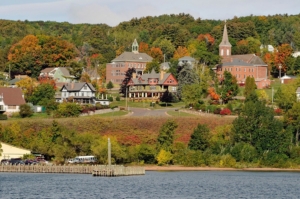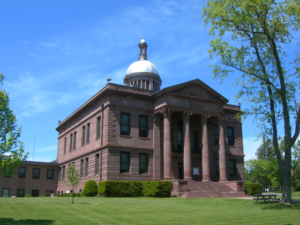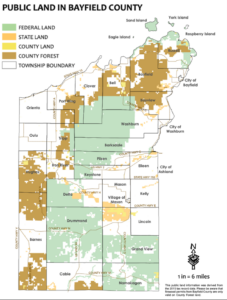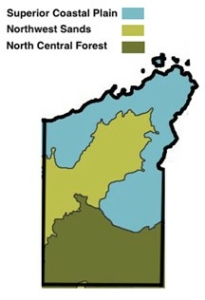michigan
The Steady State of Beautiful Bayfield County
by Dave Rollo

The port town of Bayfield, Bayfield County, Wisconsin. (Wikimedia Commons).
Bayfield County, Wisconsin is situated on the shores of Lake Superior, the largest freshwater lake in the world by surface area. Deep in the heart of the Great Northwoods, the county is unique in its glaciated beauty. It also happens to be a rare example of a county in harmonious balance between its natural and constructed communities.
Bayfield County has been refreshingly free of growth controversies and displays key attributes that approach the characteristics of a steady-state county. Its citizens understand the value of local forests and farmland, and they embrace a conservation ethic that guides their stewardship of county resources. A regional land conservancy is active and respected in the community, and citizens understand the benefits of local agriculture.
Of special interest to the Keep Our Counties Great campaign, the conceptual framework for a steady state economy is established in the Bayfield County Comprehensive Plan. The plan embraces sustainability, systems thinking, and climate resilience.
A Stable Economy and Careful Planning
Bayfield County has had a low and stable population (approximately 15,000 residents) for more than 40 years. It’s also had a stable GDP of $400 -$450 million. Although residents’ income is slightly below the U.S. mean, security of home ownership is much higher than the national average, 87 percent compared to less than 66 percent nationwide.
While Bayfield enjoys a relative lack of controversy over growth and development, it shares challenges with other communities. These include home affordability and a shortage of housing for seniors. In response to these challenges, the County Board okayed construction of 60 workforce and retirement housing units in Washburn, the county’s largest community. Notably, however, the county integrated this additional housing within town boundaries. And it granted approvals primarily in response to the needs of the community rather than a developer’s pursuit of profit. Indeed, local officials seem averse to the typical sprawling housing tracts that are so common elsewhere.
Take, for example, the case of the local landowner who petitioned Bayfield’s Plan Commission to build a subdivision on a parcel of more than 100 acres. The parcel sat on a high bluff with striking vistas, a tempting place to build homes. But the commission voted it down, partly because the land was situated within an orchard district. Instead, a plan commissioner encouraged the landowner to contact a local land conservancy to explore an alternative idea focused on preservation.

Government agencies in Bayfield are attentive to conservation of resources. (Jimmy Emerson, Flickr)
The conservancy received this suggestion warmly. And it aligned with the Farmland Preservation Program that guides local planners. Together, the landowner and the conservancy created the Fire Hill Preserve, a recreation area that conserves the parcel’s woods and includes a trail system for residents and visitors.
Bayfield County’s planners have methodically evaluated and mapped all the farmland in the county to conserve the agricultural base. Amazingly, that base is growing; farm acreage increased by 13 percent over the last decade. The number of farms increased over the period too, to more than 400, so average farm size fell. One-third of the farms are less than 50 acres in size. Individuals or families constitute more than 95 percent of the owners of Bayfield County farms.
Bayfield County has created a thriving local food economy featuring a consortium of growers, the Bayfield Foods Farmers Cooperative. The coop maintains a year-round CSA (Community Supported Agriculture) program, whose customers purchase portions of the farms’ harvests, which comprise some 200 foods. The coop offers easy access, with 20 locations for pick-up. It also provides bulk food purchases and wholesale deliveries to stores and restaurants. The coop’s mission is to “re-build local food systems.”
The county food system includes nine farmer’s markets, one on the Chippewa tribal land, the Red Cliff Mino Bimaadiziiwin Tribal Farm Stand. As promoted by the Bayfield County government, local food has a multiplier effect, yielding twice as much income for the local economy as imported food. Recirculating dollars locally is a hallmark of a sustainable economy. It pays dividends in keeping farmland protected and providing employment in the county.
A Focus on Biocapacity
Biocapacity describes the regenerative capacity of an area, while the ecological footprint refers to the acreage required (within the area or elsewhere) to support the economy of the area. Biocapacity is the ultimate basis for the human economy and from a sustainability perspective should be larger than a community’s footprint. At the global level, humanity’s footprint exceeds the planet’s total biocapacity. Few counties have undertaken assessments of their biocapacity and footprint, which makes care for the local environment especially important.
Indeed, careful management of local biocapacity is a prerequisite for a steady state economy. This ethic is evident in the careful oversight of forests and farms by Bayfield County planners. The forests of Bayfield County, comprising 85 percent of the county, provide area for sustainable timber harvesting, wildlife habitats, and a repository for carbon, the sequestration of which is a recently recognized economic service in the county.
The Northwoods region is a contiguous belt running from northern Michigan through Wisconsin and into Minnesota. It is regarded as globally significant for water resources, biological species diversity, and carbon storage. Bayfield County’s biocapacity is certainly important locally. And it is integral to the ecological and climatological functioning of the Northwoods and, by extension, Earth.
Bayfield County was not always a model of biocapacity conservation. As was common a century ago in the upper Midwest, Wisconsin lost nearly all its northern forests to logging. Much of the denuded landscape was not capable of supporting agriculture, either. During the Depression, when many landowners could not pay their taxes, the county government acquired the land. Today, the county owns and manages nearly 170,000 acres. Forests have regenerated and the landscape has repaired itself, largely because the land is held in public ownership by federal, state, and county agencies.

Public land held by county, state and federal agencies.

The ecological landscapes of Bayfield County.
Indeed, Bayfield is exceptional in having half of its land held publicly in a state where 85 percent of the land is privately owned. Moreover, Bayfield forests comprise the third-largest county forest in Wisconsin. The state legislature established them in 1927. Since then, harvesters have managed the county forests responsibly, providing around $5 million annually in timber product sales. Now the biocapacity of Bayfield County is generating income not just from timber products but also from carbon sequestration.
In 2021, Bayfield County registered 90 percent of its forests in a voluntary, 40-year carbon offset program with the American Carbon Registry. County officials are working with ANEW, a market-based emissions-reduction consultancy, to generate and market carbon credits. They are using a stringent methodology for assuring the integrity of the offsets.
It’s not clear, however, how the program deals with the Achilles’ heel of offsets. Generating money to purchase carbon credits from Bayfield County (or any county) entails an environmental impact somewhere else, due to the trophic requirements of economic activity. Brian Czech calls this thorny dilemma the “trophic conundrum.” He further argues that the environmental costs of generating money tend to exceed the environmental benefits of spending that money, even on conservation programs. This doesn’t mean forest conservation is a bad idea. Quite the opposite. But it points toward the importance of regulatory policy for conservation, as opposed to the strained attempts to perform conservation with market mechanisms.
In any event, the Bayfield arrangement is expected to provide nearly five million metric tons of carbon credits in the first 20 years of operation, more than offsetting the emissions of the Bayfield county population. The project was the first of its kind on county forest land in the USA.
The Bayfield County Forest Comprehensive Land Use Plan focuses on sustainable practices. It mirrors the County Comprehensive Plan’s commitment to sustainable community development. Its aim is to avoid generating environmental impacts that compromise the prospects of future generations. The Forest Comprehensive Land Use Plan is unique among such plans. It includes input by the Red Cliff Band of Lake Superior Chippewa. Their reservation is located along the coast within Bayfield County. Their voice is integral to forest management practices, and is provided biannually by the Bayfield County Tribal Relations Committee.
Another crucial component of protecting the biocapacity is a conservation land trust that evaluates critical habitat for preservation. The Landmark Conservancy is a regional land trust with key landholdings in Bayfield County. It has developed a strategic conservation focus that concentrates efforts for climate resiliency on 17 focus areas within its region. Four of the 17 are located in Bayfield County with the largest area, the Lake Superior South Shore Streams, coinciding with the Lake Superior Coastal Plain. This coastal plain is particularly important for shorebirds that are among the most threatened bird guilds. Their populations have declined by 50 percent over the past 40 years. In fact, the area is vitally important as a migratory route for a variety of birds.
Landmark Conservancy and county officials have also collaborated on land protection in Bayfield County. Recently they worked on the purchase of 3,900 acres of forests to safeguard migratory bird habitat.
Comprehensive Planning with a Systems Approach
Clearly, Bayfield County officials hold a vision for land planning and development that emphasizes protection and preservation of its lands and natural systems. Indeed, Bayfield County begins its 2023 Comprehensive Plan with a commitment to a “future that places sustainability, systems-thinking, and climate change resilience at its core.” The Plan focuses on seeing community facets in an integrative way, rather than in isolation. In the words of the authors, “the approach views a community as a dynamic and interconnected system, rather than a collection of separate parts.”
Public land held by county, state and federal agencies (left) and the ecological landscapes of Bayfield County (right). All of Bayfield’s ecological landscapes are within the Northwoods Country.
The State of Wisconsin mandates the nine elements of the plan, so they are common to other plans. But the Bayfield plan’s focus on interrelationships of community is unique and rare in county plans. By understanding how actions in one area affect others, policymakers and officials are less likely to do harm.
Traditional policymaking often fails to capture a policy’s full costs or account for negative “externalities”—side effects that are external to the policy’s primary goal. By contrast, an integrative, holistic approach to policymaking doesn’t seek to accomplish one goal while neglecting others. It takes full account of the costs of a policy, which helps to minimize negative side effects.
The plan does not explicitly prescribe limits to county growth. But it subjects growth and development decisions to a range of considerations relevant to a long-term sustainable future. Growth is not a driver within the comprehensive plan; indeed, it is only briefly mentioned. The many needs of the community place bounds and constraints on quantitative growth and prioritize qualitative development.
Advancing a Path to Steady State
Steady-state economics is a response to a systems failure in conventional economics and flawed societal assumptions about infinite growth. These failures to integrate systems thinking into planning are degrading ecosystems and jeopardizing human flourishing—and perhaps humanity’s survival—as economies worldwide increasingly approach and exceed planetary boundaries.
Communities need a holistic approach to planning and a respect for biocapacity if they are to counter the present-day inertia of growth. By establishing an integrated, systems-based approach to its comprehensive planning, Bayfield County is moving toward developing a community consensus on reducing negative externalities in policy making. There is room for improvement, to be sure. For example, the county would do well to swap out its market-based carbon sequestration program for regulations that prohibit forest cutting to ensure long-term forest health.
Still, Bayfield is an encouraging example of a county that stewards its resources. Instead of a siloed approach to county planning, Bayfield County officials recognize their county as a complex adaptive system. The County is committed to protecting and enhancing its biocapacity and including indigenous perspectives in its planning. It stands as a steady-state model for other communities to follow.
Dave Rollo is a Policy Specialist and team leader of the Keep Our Counties Great campaign at CASSE.

The post The Steady State of Beautiful Bayfield County appeared first on Center for the Advancement of the Steady State Economy.
Cartoon: Republican primaries' cryptid candidates
Follow me on Mastodon, Facebook, Instagram, or at my website.
